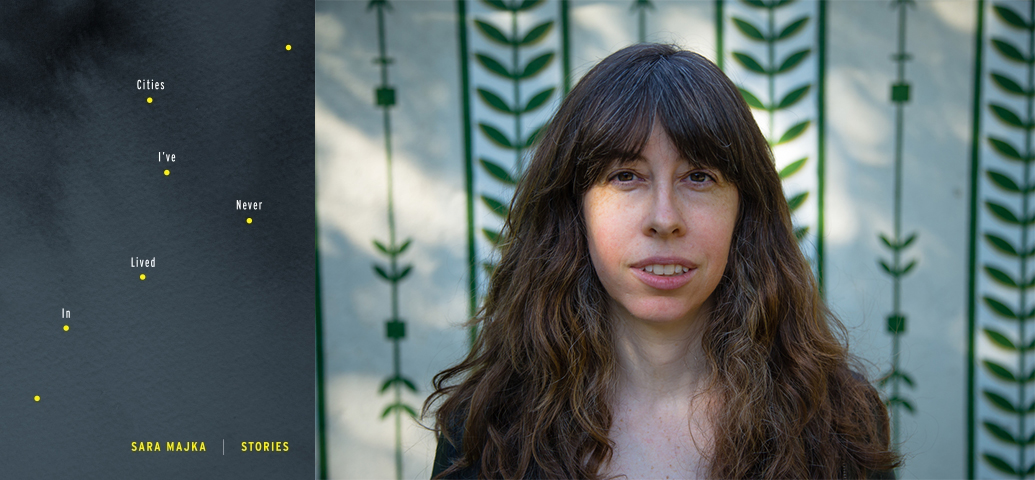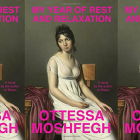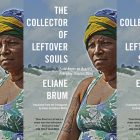Searching for Artifacts: An Interview with Sara Majka

Author photo credit: Chris Ward
In the opening piece in Sara Majka’s haunting debut collection of linked stories, Cities I’ve Never Lived In, the narrator announces that she is in the middle of a divorce and about to board a train into a city. Her solution to her problems is “to move from place to place, trying to thread together, if not our marriage and our lives, then something in ourselves.”
In their attempts to find themselves, the characters in Cities I’ve Never Lived In drift through towns that look like they belong to faded photographs of a lost New England. In one story, a character’s parents disappear and his island home can’t be found on any maps. Later, he befriends a woman who looks like his missing mother. In another story, a man sees a younger version of himself in a painting found in an attic. In yet another story, the narrator sees herself as a child in an old museum security tape.
This is a world of doubles and lost artifacts. “Perhaps I like the magical qualities of not being able to find a place again,” the narrator says at one point. And yet, Majka’s characters keep searching for a familiar view, for elusive childhood mementos—as if they “had all gone somewhere in a dream together.” If these characters travel in order to find themselves, they are successful in their endeavor: they find versions of themselves again and again.
A few weeks ago, Sara Majka and I exchanged long emails about what draws people to places they’ve never lived in, motherhood, and New England folklore.
Bruna Dantas Lobato: Tell me about the moment when you realized that your stories were thematically linked.
Sara Majka: I had a hard time finding an agent (I finally got my terrific agent, Sarah Levitt, through lucky circumstances just as the book deal with Graywolf/A Public Space was coming through), and so I had a finished manuscript for a year or two on my hands, and I would work on it a little bit each time I sent it out, and it changed dramatically from a loose association to linked stories. I’m a purist by nature so was resistant to pushing it into linked stories, but when I finally committed to it (about a year before it was published), it was easy and made the whole thing make more sense. Once I made that decision, I also wrote two new stories very quickly.
Jonathan Lee—who was at A Public Space and is now at Catapult—helped me think about ordering it, and then my editor, Brigid Hughes, who is also what I would call a purist, would sort of ask how the stories went together, and I figured she was suggesting that they might be more closely linked with a few changes.
BDL: The recurring theme of motherhood has a powerful cumulative effect. At the end of the collection, your narrator tells her mother that she wishes to have a baby. Mothers are important in your book, and so are children who have lost their mothers. Can you talk a little bit about motherhood and motherlessness?
SM: At a certain point in my writing I realized that nearly all the stories have either parents that disappear or children that disappear, though that’s not something I would have originally thought of as a preoccupation of mine. It does appear, in hindsight, to be my biggest preoccupation. Why I don’t know. It’s hard to answer these questions without delving into my own life—my own childhood, the fact that I’m now a single mother of an infant boy—but I would like to try. I’m sitting here staring without answers, though, thinking to say something about my interest in ghost stories and a sort of mythical New England, but that doesn’t feel exactly right. I do think there’s an emotional remove in New Englanders—that old puritanical sense—where people are more isolated than they might otherwise be. I don’t dislike this quality. When that’s what you grow up with, the opposite can be quite discomfiting. But, in a way, it’s the opposite of the sense of having a mother, of warmth and love and attachment. These characters have to survive without that safety, and that’s old school, that’s old school New England, and that’s what I wanted to write about.
About mothering, I recently heard about the clinical term of the “good enough” mother, that as long as you are good enough, you won’t do any harm, it’s just a matter of staying above that bar, of not abandoning your baby. When someone told me this, I was…bewildered might be the right word, because it was my thinking that if you really loved your baby, if you met all their needs, or as much as you could, and comforted them, then there was a different category for that. You could somehow ensure a sense of safety that they could keep for the future, like putting money in the bank for them. I wanted to put as much of that kind of money in the bank as I could for a baby, and I wanted to believe it worked like that.
I’ve noticed I’ve said the word safety again, which is probably how I’ll relate it back to the question about the collection, that it’s about a world without a sense of safety.
BDL: I was intrigued by those disappearances. So many of the women in your stories vanish: a young woman drowns in the ocean, another one leaves home and dies of an overdose, a wife leaves her family behind. I wondered, what is driving them away?
SM: I couldn’t come up with an answer for this, except to say it relates to the previous question. Often in the collection either a little girl disappears, or the narrator is wanting a little girl she can’t have, or the mother disappears, so it probably has to do with your previous question, creating a state of motherlessness for the children, or leaving me with a mother character who is without her child, and that’s a harsh world, and apparently one that I wanted to write about. It’s its own form of extreme forces, like someone else might write about a storm at sea. It gives you the chance to write about characters facing extremes.
BDL: Do you think there can be stories that aren’t about characters facing extremes? Is it possible to write fiction about people in a safe world?
SM: Let’s see, it’s been some time since I read either, but could there have been safety in those domestic worlds of Virginia Woolf? And certainly with Jane Austen? One book I enjoy teaching is Archipelago Books’s The Waitress Was New; it’s so subtle and there’s nothing extreme. It’s about nuances and the small rotations of the day. Stories, perhaps, operate on a more extreme register, where they can’t rely as well on pattern or accumulation. If I had more time I’d start digging through my story collections to see if this is even true, but time is—with so much regret—not something I have a lot of right now.
BDL: Your narrator is often on the road or thinking about the road. Why travel so much? What is the pull of the elsewhere?
SM: She examines that right from the beginning, saying that she’s trying in some sense to put herself back together, and that’s probably true. And so many of us have this desire for travel; there is something calming in the motion of it. It’s easy to say that we travel in order to escape ourselves, or that we travel in order to find ourselves, or to learn. But there is actually something in the motion of it, I think. The constant rocking of the trains, and of walking. I think airplanes bother me because they leave the ground; they don’t have that same motion.
BDL: The island in your story “Saint Andrews Hotel” has disappeared from the map. Later in the collection, the narrator’s mother can’t find the father’s house as she remembers it. There is a sense of placelessness and transience that pervade these narratives. The shifting grounds reminded me of something Italian photographer Luigi Ghirri once said about his travels: “Melancholy is the road sign for an effaced geography. […] Because the horizon nearly always mingles earth and sky, because the countryside also inhabits city and villages, because streets seem always to head toward the same point–and thus to nowhere.”
SM: I like that quote—I like the sound of the words, but, though I read it several times, I can’t quite make out what it’s saying.
But this sense of places changing and disappearing, of not being able to get to them, is pretty true for my experience. For instance, I spent a summer nanny-ing on one of the Elizabeth Islands off of Cape Cod. It was beautiful, perhaps the most beautiful place I had been, but it’s a private island. The Forbes family owns it and keeps it just as it was in the 19th century, so there’s a working farm, and a captain’s house (I nannied for the ferry captain), and dirt trails and stone fences, and so many deer and ticks. So beautiful. But the few workers I knew there had moved away, and you need to know someone in order to get back there. So though I have tried, and others have tried for me, I haven’t been able to get back. I don’t even remember where the ferry leaves from, and there’s no way to find the schedule. That wasn’t the story that influenced the story you mentioned (I was instead smitten with a hotel in Portland, Maine), but I was, in an overarching sense, interested in a sort of lost New England.
BDL: You mentioned your interest in ghost stories. I like the idea that these are ghost stories or, at the very least, stories about ghosts. And I also think of them as New England folk tales. Your characters often tell each other stories within the stories—they are preoccupied with a time and place they can’t return to, with this “lost New England” and with artifacts that they can’t recover from the basements and attics that permeate the book. Where do your stories come from? Are you haunted by your characters’ histories and the stories they tell?
SM: The New York Times review of my book referred to it as a gothic New England, and I really liked that term. When I started to work on the book I was in the center of Maine and going through a lonely period. I became fascinated with the coastline there, and did one trip where I started in Portland and drove up the coast ending at the very tip of Maine, in Lubec, which is an extraordinary location, one which, when looking back, seems too strange to really exist. I became obsessed with things like this, with a place such as Lubec, or Jonesport.
For instance, in Lubec, I remember seeing a faded sign for a canning factory. I didn’t write about it, but that’s the sort of thing I would have potentially become fascinated with, researching the factory, where it was, who worked there. I was lonely and my mind was doing some strange things, and I think, had my interest in the canning factory taken over, I would have become convinced that one of my characters really worked there, and I would have searched online for a record that they did. I would be searching for artifacts and relics that didn’t actually exist. This happens in the book with the artwork, and the maps, and all those other things.
About Author
Bruna Dantas Lobato is a writer and literary translator from and to Portuguese based in New York City. She is the fiction editor of Washington Square Review. Her work has appeared or is forthcoming in BOMB, The Millions, Music & Literature, Words Without Borders, and elsewhere. She is originally from Natal, Brazil.



